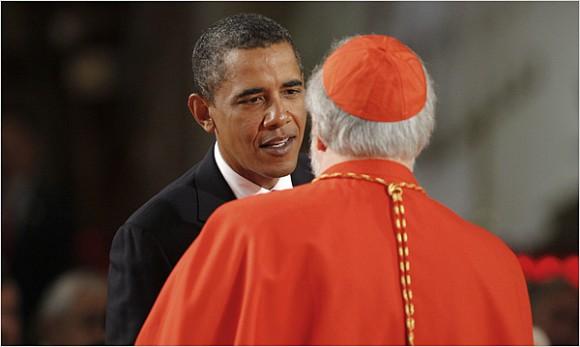How Does the Vatican Influence US Policy?
Church and State
Editor’s note: The following comes from Chapter 10 of N4CM Chairman Dr Stephen D Mumford’s book, American Democracy and the Vatican. How does the Vatican influence U.S. policy? In hundreds of ways. Most important in creating many of these opportunities is the Church’s almost unimaginable wealth. Recently Luigi Di Fonzo, a Harvard professor, published an extensive study of Vatican wealth. “The Vatican’s total assets—not including the assets of the Roman Catholic Church, but including stock it controls on the New York and American stock exchanges, and property, gold reserves, and paintings—are probably $50 billion to $60 billion. . . .[43] The Catholic Church in the United States, with “assets of more than $100 billion, today possesses more than ten times the combined wealth of IBM, Exxon, General Motors, and U.S. Steel.”[44] There is no accountability for these funds to anyone except the Vatican. Everything is done in complete secrecy.[45] It is simply mind-boggling to see Vatican claims of compassion for the poverty-stricken in Latin America in the face of this fantastic accumulation of wealth. Given our tax laws, and in the continued absence of any kind of redistribution of this wealth, the Church will continue to amass wealth indefinitely. Mexico was witness to the behavior of the Church that we are seeing in the United States today. By the time of its independence, the Church in Mexico had acquired perhaps half the land and capital wealth of the country. This is the reason that in Latin America “priests have become identified in the minds of the people with exploitation, superstition, and tyranny.”[46] One of its most important accomplishments is instilling children in its school system with the idea that Catholics are persecuted, that non-Catholics are determined to injure them, that all criticism of the Church and its hierarchy is directed against them personally. Children are taught to reject all criticism of the Church as being unjust, to be angered by this criticism, to hate the individuals at the source of the criticism. Catholic children who are active in the Church are “programmed” to respond this way. The thought process is blocked in such a way that negative information about the Church cannot be received and evaluated by using one’s intelligence. Instead, it is automatically rejected no matter how truthful or justified it may be. The hierarchy is a master at capitalizing on the anger and hatred generated by this criticism, capturing it, and channeling it in ways to make it productive for the advancement of its own agenda. This generates the considerable human energy that drives Catholic Action and many individual Roman Catholics. The hierarchy avoids most direct attempts to influence policy. These activities are restricted to vociferous support for a public policy or announcements that they will lead a defiance movement if a certain policy is enacted. As Congressman William Clay (D-Missouri) found (see, note twenty-six, chapter one), whenever any issue arises in Congress that affects Catholic interests, a seasoned lobbyist in priestly garb is likely to appear in a Congressman’s office reminding the legislator that 52 million Catholics in America feel thus and so about this matter. Even when the legislator knows full well that the opinion is actually that of a handful of top-ranking bishops, acting on orders from Rome, he may swallow his convictions and say, “Yes, yes,” because he is aware that in America the powerful bishops speak for American Catholics. Should he not comply, Catholic pressures can be mortally effective in swinging any close election against him.[47] The hierarchy has learned to act indirectly through Catholic laypersons. The hierarchy acts through Catholic politicians such as Lindy Boggs (D-Louisiana) and Charles Rangel (D-New York). There are many similar examples directly affecting population growth control. Ravenholt, in his memo, pointed to several acts of Clement Zablocki (D-Wisconsin). Other obvious examples include Tip O’Neill (D-Massachusetts), who killed the Simpson-Mazzoli bil in a thinly veiled act in December 1983, Henry Hyde (D-Illinois), and Jeremiah Denton (R-Alabama). They act through hundreds of bureaucrats such as John H. Murphy and John H. Sullivan, as Ravenholt pointed out in his memo. They act through Catholic laypersons not associated with the government, such as Paul Brown, executive director, Life Amendment Political Action Committee (LAPAC), Phyllis Schlafly, executive director of Eagle Forum, and Peter Donaldson and John Ganly of Family Health International. The hierarchy has also learned to act indirectly through political, bureaucratic, and religious “independents”—non-Catholics who have something to gain by cooperation. Examples include Jesse Helms (R-North Carolina), Robert Kasten (R-Wisconsin), and Mark Siljander (R-Michigan), who were elected with considerable assistance from the hierarchy and are dependent upon its continued support, financial and otherwise, for reelection. The Helms Amendment that has blocked international population assistance for abortion activities for a decade was written by John H. Sullivan, a Catholic. Examples of non-Catholic bureaucrats who have “cooperated” with the Church include Sander Levin and Dr. Stephen Joseph, two key figures mentioned in Ravenholt’s memorandum. Examples of nongovernment non-Catholics who have “cooperated” with the Church include Malcolm Potts and Sharon Camp. I can name scores of non-Catholics in these categories just from my own experience in population and I am sure that population is only the tip of the iceberg. In a sense, the non-Catholics are the most important to the Church for influencing policy. They allow the hierarchy to keep their hands perfectly clean.
|
.
Any original material on these pages is copyright © BishopAccountability.org 2004. Reproduce freely with attribution.
